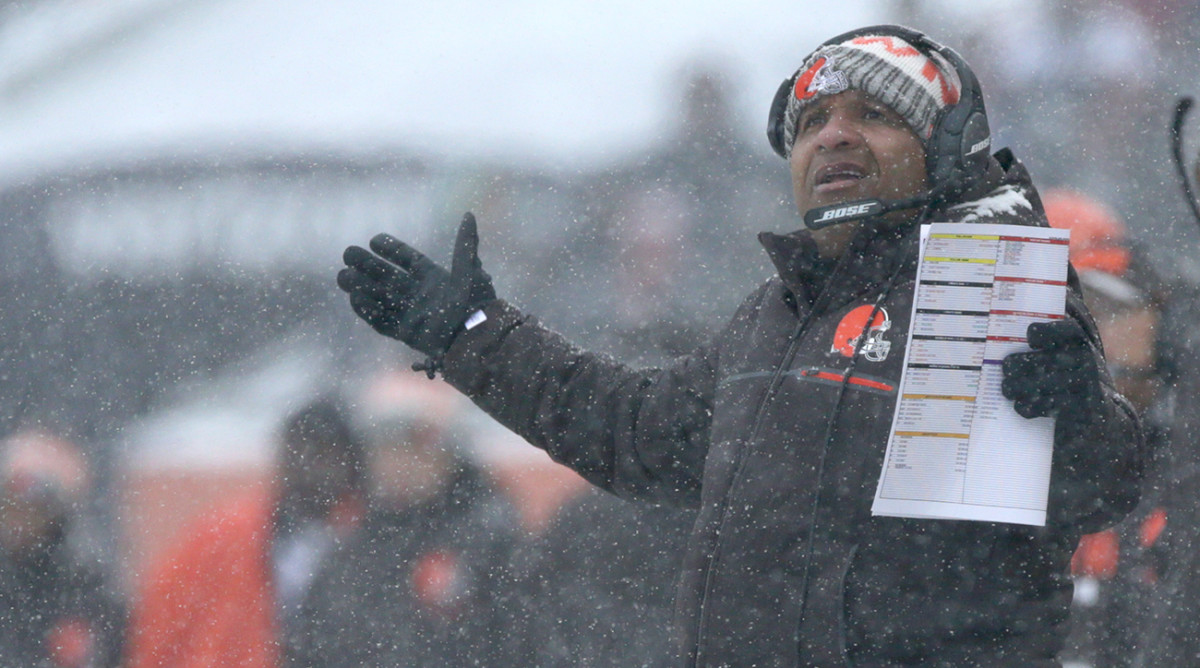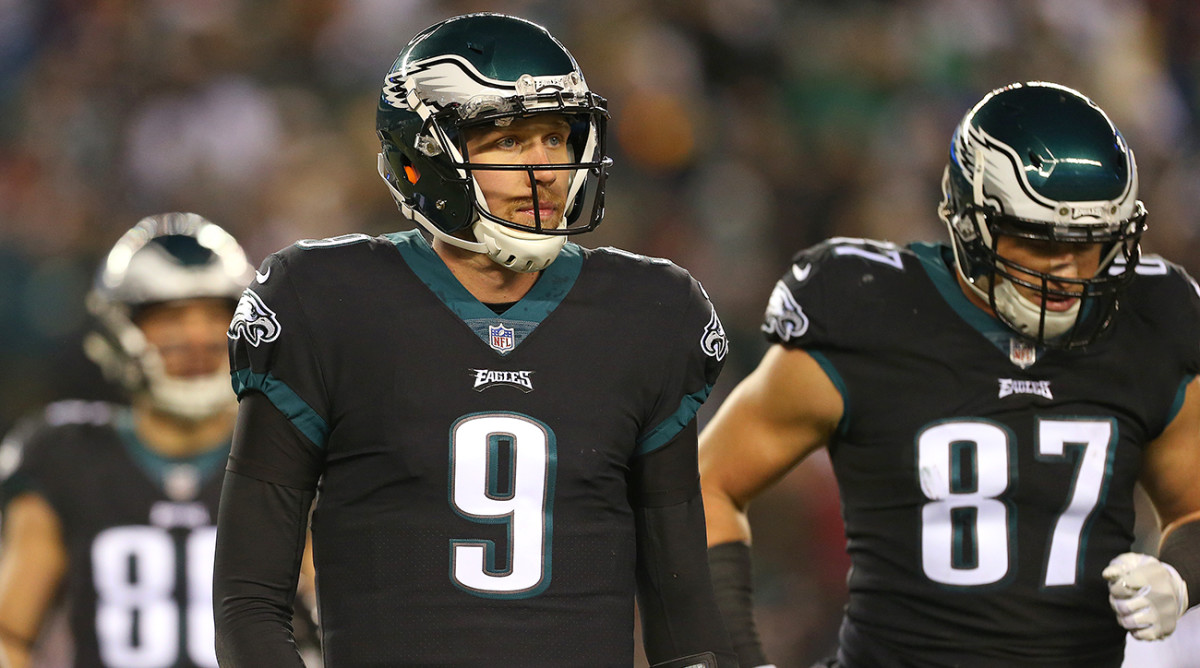What to Do About Hue Jackson

At the end of 2015, after losing 45 games over four seasons since purchasing the Browns, Jimmy Haslam decided to do something radical and implement a Moneyball-style front office. The Browns would approach football the way so many MLB teams, starting with Billy Beane’s Oakland Athletics in the early 2000s, had approached baseball. Haslam hired Beane’s former righthand man, Paul DePodesta, as Chief Strategy Officer and built an analytics-driven front office around him.
Purists thought it would never work. Professional football, an infinitely more complex sport than baseball, has more variables and contingencies than analytics alone can capture. New-age data has a place, but not at the head table. That said, even football’s purists agreed: If you are going the analytics route, you need to commit for at least four or five years. The model isn’t built for immediate turnarounds.
Haslam gave it a little under two years. After the Browns lost for the 27th time in 28 games, he fired head personnel man Sashi Brown and hired an old school football scout, John Dorsey, to run his front office. (No word yet on what will happen to Brown’s Lieutenant, DePodesta, who remains on staff.) Dorsey’s first big decision will be whether to keep head coach Hue Jackson, a fellow football purist. That is, if Dorsey will be allowed to make that decision.

Haslam said in early December that Jackson’s job is safe. People within the NFL are skeptical. Surely an owner who has lost 75 games with four different coaches in six years knows by now that he should let the man he just hired to run his football operations make the most operative football decision of all. But when asked about Jackson’s status on December 19, Dorsey said, “Ownership has spoken on that question.”
That’s not exactly a personal endorsement of the head coach, but a few days before that, Dorsey had, albeit somewhat indirectly, defended Jackson by saying that the previous front office “didn’t get real players.” Dorsey has since walked back from that, but with the sweeping philosophical front office change that his presence represents, the perception remains that Jackson’s 0-15 Browns have a grossly flawed roster. That’s wrong.
The Browns have one of the NFL’s better offensive lines. They have a quality thunder and lightning backfield with Isaiah Crowell and Duke Johnson. They have an athletic first-round rookie tight end, David Njoku. Their receiving corps needs help, but with second-year man Corey Coleman healthy and Josh Gordon back, it’s no longer in dire straits. Defensively, the linebacking trio of Christian Kirksey, Joe Schobert and (when healthy) Jamie Collins is one of football’s fastest. The defensive line is adequate and getting better, given the flashes from 2017 No. 1 overall pick Myles Garrett. The secondary, a sieve in 2016 because of poor safety play, has improved after the arrivals of first-round rookie Jabrill Peppers and veteran corner Jason McCourty, as well as the progress made by 27-year-old CB Jamar Taylor. This is a roster that, frankly, should be somewhere between 4-12 and 6-10, not on the cusp of joining the winless 2008 Lions in infamy.
Cleveland’s biggest problem is the players have not been put in position to succeed—most notably on offense, and specifically at quarterback. Second-round rookie DeShone Kizer has the tools to become a quality starter. He’s physically capable of making 500-level throws at the deep-intermediate levels. He’s tough in the pocket. He’s athletic and mobile. Yes, he’s raw, and his inconsistent precision accuracy is troubling (that issue rarely corrects itself). But quarterbacks with greater flaws have had successful NFL careers.
Kizer was thrown into the deep end with no life vest. When you put on Browns film, every week you see the offense line up in balanced spread formations and run traditional downfield route designs. It’s either isolation patterns or route combinations that are constructed in ways that require receivers to win one-on-one. The Browns, for much of the season, simply didn’t have receivers who can do that. And yet Kizer has been asked to drop back and get them the ball on full-field progressions reads. Some of those pass designs correlate with Cleveland’s respectable ground game, but the fusion is nothing like what you see from, say, the Rams or Eagles. The offense’s predictability has made it easier for defenses to disguise their looks and be aggressive. From Kizer, not surprisingly, there’s been a barrage of awful turnovers.
One NFL insider who watched the Browns closely in the preseason said that it appeared Jackson would put a full-fledged, classic dropback passing game on Kizer’s plate and just live with the growing pains. Except Jackson hasn’t lived with the growing pains—not entirely, anyway. He benched Kizer in Week 5 and again in Week 7. He’s been plainspoken about Kizer publicly, and Kizer has admitted that his confidence is rattled.
To be fair, Kizer has made things hard on Jackson. The first benching was understandable; Kizer was locking tighter and tighter onto bad reads and, by the end of the second quarter, he was taking extra hitches at the top of his dropbacks. And some of Kizer’s recent interceptions would be grounds for benching if they’d come from a veteran who knows better.
But the interceptions are a byproduct of a quarterback who has been asked all season to play beyond his comfort zone. Cleveland’s offense is not overly complex in the pre-snap phase, but once the ball is in play, you could argue that no system in football puts more of a burden on its quarterback. Kizer must make every read on his own. In other systems, ranging from Jared Goff’s in Los Angeles or Tom Brady’s in New England, there are many reads presented to the quarterback. You see those teams employ pre-snap motion that forces a defense to reveal its coverage. You see route combinations that beat anticipated coverages, and formation wrinkles that coax defenses into those anticipated coverages. You see play-action passes that derive directly from the ground game and present either/or looks early in the down. You see rub routes and stack releases that get receivers open quickly. You see receivers running intertwined routes downfield that get them open late. All of these are plays where a quarterback doesn’t make a decision so much as he just executes a design. You rarely see it in Cleveland, even though Jackson was great with such tactics as the offensive coordinator in Cincinnati.
Questions abound with coordinator Greg Williams’ defense, too. The one nobody can answer: Why do the safeties play so freakin’ deep? Cleveland’s safeties routinely align 18-20 yards off the ball, and offenses routinely complete 15- to 18-yard passes in front of them. Williams has also played a ton of base 4-3 personnel, lately even when the offense goes with extra wide receivers in obvious passing situations. Because linebackers can’t cover wide receivers man-to-man, the Browns are obligated to constantly play zone. They do, often while bringing a disguised blitz. It’s a boom-or-bust approach that’s great when it works but horrible when it doesn’t. Most defenses only play this way if they have quality cover guys and an iffy front seven. That’s not necessarily Cleveland’s makeup.
This coaching staff wasn’t put in a great position. It was forced to work with a front office that saw football through a flawed prism. But good coaching means adapting to your players. That hasn’t happened in Cleveland. If this downtrodden franchise’s fortunes are to change, Haslam can’t take the ridiculous half-measure of hiring a new GM but forcing that GM to keep the old coach. Dorsey must be allowed to pick his own guy.

FILM TWEET ELABORATION
#Lions rookie Jarrad Davis has the chance to be one of the 3 or 4 best LBs in NFL very soon. Matter of how quickly he learns.
— Andy Benoit (@Andy_Benoit) December 21, 2017
We’ll see if he can get there. Jarrad Davis lost some passing-down snaps in December to fourth-round rookie Jalen Reeves-Maybin, which is a little perplexing (Davis had been playing every snap for much of the season). But Davis’s raw ability is unparalleled. He’s thick and limber and naturally efficient working to the ball. The truly great linebackers are the ones who know not just where the ball is, but where it is going. My sense is Davis can become that guy.
CAUSE FOR CONCERN
Nick Foles was 19 of 38 for 163 yards against the Raiders Monday night. There was a choppiness to his dropback timing, and we never saw any sort of rhythm from Philadelphia’s passing game—this against a Raiders back seven that has struggled mightily for much of 2017. The Eagles can compete with Foles, but it will take a group effort. He’s not twitchy and so he needs more space (and thus time) in order to throw. He also doesn’t have Carson Wentz’s late-in-the-down playmaking prowess. It’s hard to overstate how critical that was for Philadelphia.
KEEP AN EYE ON
The Jimmy Garoppolo hype. I’m buying in because his marriage to Kyle Shanahan looks like one made in heaven. As a passer, Garoppolo is, in many ways, the anti-Foles—he does have quick twitch and he doesn’t need much time or space to release the ball. He’s the perfect style of quarterback for a Shanahan passing game that features a lot of timing-based, in-breaking patterns and route combinations out of empty sets (especially in base personnel).
INJURY IMPACT
If the Seahawks make the playoffs, it will be hard for them to go very far with Richard Sherman and Kam Chancellor out. It’s not just missing two stars, it’s that Seattle is very much an execution-based defense. Most snaps bring either Cover 3 zone or man-to-man with either a blitzer or robber. The simplicity of it allows defenders to play fast, but it also allows the offense to know where those defenders will be. That makes it easy to draw plays that exploit backup defensive backs like Byron Maxwell (filling in for Sherman) or Bradley McDougald (in for Chancellor). And there are several NFC playoff teams, like the Rams, Eagles, Saints and Vikings, who are great at dictating matchups through aerial designs.
NON-FOOTBALL THING ON MY MIND
No one under 21 who commits a moving vehicle violation should ever be let off with a warning. Every offense should be ticketed every time, no exceptions. In my first five years of driving, I was pulled over 22 times for a variety of minor offenses, none more serious than speeding. I got four tickets and 18 warnings. After about the 11th or 12th stop, the warnings became a badge of honor and I bragged about their accumulation. I became a more arrogant driver, which, at that age (and maybe all ages), meant a more dangerous driver. I sped all over town. The only thing more obscene than my acceleration off of green lights was my deceleration into red ones. I changed lanes far too often. My mind always went fast and so it was only right that my car did too. Everyone else and their slower minds were the problem.
Today, at 31 and having been pulled over just twice in the last 10 years, I find myself fantasizing about acts of furor when kids in my neighborhood drive the way I once did. Warnings are victories for young drivers. Victories for them are defeats for the rest of us. And yes, writing this has made me feel incredibly old. But if just one cop out there reads it and gives just one extra ticket to one smarmy, piece-of-crap punk like myself, it’s worth it.
• Question or comment? Email us at talkback@themmqb.com.
